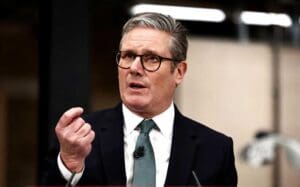Wage growth in the UK has slowed to its weakest level since November, while unemployment has crept higher, as businesses brace for a series of cost pressures including tax hikes and a rise in the national minimum wage.
According to new data from the Office for National Statistics (ONS), regular pay excluding bonuses rose by 5.6% in the three months to March — down from 5.9% in the previous period and below analysts’ expectations of 5.7%. Including bonuses, total pay increased by 5.5%.
Salaries in the private and public sectors rose by 5.6% and 5.5% respectively, marking the twenty-second consecutive quarter in which wage growth outpaced inflation, which stood at 2.6%.
Meanwhile, the UK’s unemployment rate ticked up to 4.5%, from 4.4% previously. Data from HM Revenue & Customs also showed a decline of 106,000 in the number of payrolled employees compared to a year earlier, bringing the total to 30.3 million — a 0.3% annual fall.
Job vacancies continued to fall, dropping by 42,000 to 761,000 in the latest quarter — well below the peak of 1.3 million seen in early 2022. However, the economic inactivity rate — representing those neither in work nor seeking employment — edged down by 0.2 percentage points to 21.4%.
Despite the declines, some economists remain cautious about drawing firm conclusions due to concerns over falling response rates to the ONS’s labour force survey.
Liz McKeown, director of economic statistics at the ONS, acknowledged the trend: “Wage growth slowed slightly in the latest period but remains relatively strong, with public and private sectors now showing little difference. The broader picture continues to be of the labour market cooling.”
She noted the continuing decline in job vacancies and payroll employment as signs of a softening employment landscape.
The slowdown in wage growth comes as many employers boosted pay ahead of April’s 6.7% minimum wage increase. Simultaneously, the £25 billion rise in employers’ national insurance contributions, also introduced last month, has prompted many firms to curb recruitment and moderate future wage settlements.
The data will be closely scrutinised by the Bank of England’s Monetary Policy Committee (MPC), which considers wage growth and employment trends key indicators in assessing whether inflation is on track to return to the 2% target.
James Smith, developed markets economist at ING, said: “Hiring conditions are cooling, and this is very gradually putting downward pressure on wage growth. That’s good news for the Bank of England, though it will want to see a few more months of improvement before drawing any firm conclusions.”
Matt Swannell, chief economic adviser to the EY ITEM Club, echoed this caution, adding: “While it is heading in the right direction, pay growth remains significantly above the rates the Bank of England views as consistent with inflation stabilising at the 2% target.”
Last week, the MPC narrowly voted 5–4 in favour of a 0.25 percentage point rate cut, bringing the base rate down to 4.25% — its lowest in two years. While investors expect two further quarter-point cuts by the end of 2025, several committee members have signalled that any resurgence in wage growth could delay additional reductions.
Markets responded modestly to the ONS report, with sterling rising 0.23% against the dollar to $1.32, and the yield on 10-year UK government bonds climbing 2 basis points to 4.679%. The FTSE 100 held steady, reflecting a cautious but stable outlook.
With signs pointing to a cooling labour market and moderating pay growth, attention now turns to whether these trends will persist long enough to allow further loosening of monetary policy — and support a soft landing for the UK economy.






